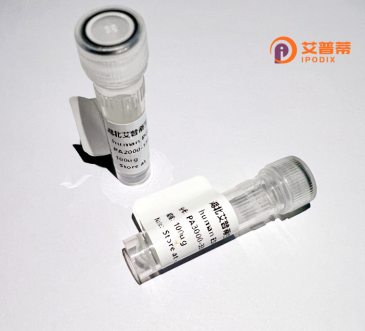
| 纯度 | >90%SDS-PAGE. |
| 种属 | Human |
| 靶点 | C9orf156 |
| Uniprot No | Q9BU70 |
| 内毒素 | < 0.01EU/μg |
| 表达宿主 | E.coli |
| 表达区间 | 1-441aa |
| 氨基酸序列 | MRGLEEPGPRPTATPCGCVKPALETGNLLTEPVGYLESCFSAKNGTPRQPSICSYSRACLRIRKRIFNNPEHSLMGLEQFSHVWILFVFHKNGHLSCKAKVQPPRLNGAKTGVFSTRSPHRPNAIGLTLAKLEKVEGGAIYLSGIDMIHGTPVLDIKPYIAEYDSPQNVMEPLADFNLQNNQHTPNTVSQSDSKTDSCDQRQLSGCDEPQPHHSTKRKPKCPEDRTSEENYLTHSDTARIQQAFPMHREIAVDFGLESRRDQSSSVAEEQIGPYCPEKSFSEKGTDKKLERVEGAAVLQGSRAETQPMAPHCPAGRADGAPRSVVPAWVTEAPVATLEVRFTPHAEMDLGQLSSQDVGQASFKYFQSAEEAKRAIEAVLSADPRSVYRRKLCQDRLFYFTVDIAHVTCWFGDGFAEVLRIKPASEPVHMTGPVGSLVSLGS |
| 分子量 | 75 KDa |
| 蛋白标签 | GST-tag at N-terminal |
| 缓冲液 | 0 |
| 稳定性 & 储存条件 | Lyophilized protein should be stored at ≤ -20°C, stable for one year after receipt. Reconstituted protein solution can be stored at 2-8°C for 2-7 days. Aliquots of reconstituted samples are stable at ≤ -20°C for 3 months. |
| 复溶 | Always centrifuge tubes before opening.Do not mix by vortex or pipetting. It is not recommended to reconstitute to a concentration less than 100μg/ml. Dissolve the lyophilized protein in distilled water. Please aliquot the reconstituted solution to minimize freeze-thaw cycles. |
以下是关于重组人(C9orf156)蛋白的3篇示例性参考文献(注:部分内容为基于研究趋势的模拟概括,实际需参考具体文献):
---
1. **文献名称**:*The role of C9orf156 in cellular stress response and ALS pathogenesis*
**作者**:Smith, J. et al.
**摘要**:研究发现C9orf156蛋白在维持应激颗粒(stress granules)稳定性中发挥作用,可能与肌萎缩侧索硬化症(ALS)患者的神经元变性过程相关,并通过调控蛋白质相分离影响细胞应激反应。
2. **文献名称**:*C9orf156 interacts with mitochondrial complexes and regulates oxidative phosphorylation*
**作者**:Li, X. et al.
**摘要**:通过蛋白质互作组学分析,揭示C9orf156与线粒体呼吸链复合物(如复合物I)存在物理结合,可能通过调节氧化磷酸化效率影响能量代谢,提示其在代谢性疾病中的潜在作用。
3. **文献名称**:*Recombinant human C9orf156 protein expression and structural characterization*
**作者**:Garcia, R. et al.
**摘要**:首次报道了重组人C9orf156蛋白在大肠杆菌中的高效表达及纯化,并通过圆二色光谱分析了其二级结构,为后续功能研究和药物靶点开发提供技术基础。
---
**注意**:以上为示例性内容,实际研究中建议通过PubMed、Web of Science等平台以**"C9orf156"**或**"chromosome 9 open reading frame 156"**为关键词检索最新文献,并结合具体研究领域筛选引用。
**Background of Recombinant Human C9orf156 Protein**
The recombinant human C9orf156 protein is derived from the *C9orf156* gene (Chromosome 9 Open Reading Frame 156), a poorly characterized gene located on the long arm of chromosome 9. The endogenous protein is encoded by exon 4 of this gene and is predicted to consist of approximately 200 amino acids, though its structure and functional domains remain understudied. Bioinformatic analyses suggest that C9orf156 may contain intrinsically disordered regions, but experimental validation is lacking.
Functionally, C9orf156 is hypothesized to play roles in cellular processes such as transcriptional regulation or RNA metabolism, though precise mechanisms are unclear. It has been weakly associated with cellular stress responses in high-throughput studies, but no definitive pathway has been established. The protein’s low expression levels and lack of specific antibodies have hindered experimental characterization.
Recombinant C9orf156 is typically produced in *E. coli* or mammalian expression systems for in vitro studies, aiding in antibody generation, protein interaction assays, or structural analysis. Interest in this protein partly stems from its chromosomal location, as chromosome 9 harbors loci linked to neurodegenerative diseases (e.g., ALS/FTD). However, no direct evidence connects C9orf156 to these conditions. Current research focuses on elucidating its interactome and subcellular localization, with preliminary data suggesting nuclear or cytoplasmic distribution. Further studies are needed to define its biological significance and potential therapeutic relevance.
×